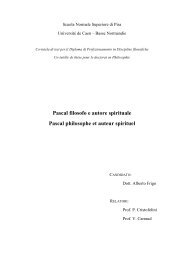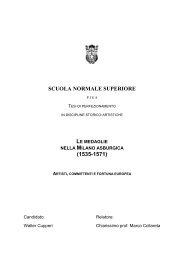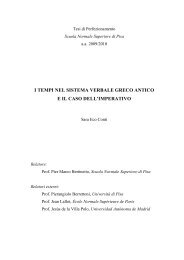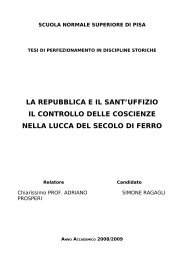CATULLUS 68 - Scuola Normale Superiore
CATULLUS 68 - Scuola Normale Superiore
CATULLUS 68 - Scuola Normale Superiore
You also want an ePaper? Increase the reach of your titles
YUMPU automatically turns print PDFs into web optimized ePapers that Google loves.
there is simply no need to take the time and trouble to quote one’s correspondent ad litteram, as long as one<br />
reacts to the points that (s)he has raised. (The situation is notably different in e-mail, where one can cut and<br />
paste easily.) Quinn has pointed out that “a verse letter is not a normal letter”: it is presumably written with<br />
greater care and with less haste than a letter in prose, so it would be technically easier for the author to<br />
include a verbatim quotation, even though this would probably be a very unconventional thing to do.<br />
Catullus introduces his paraphrase or quotation with the words quod scribis. The phrase is common in<br />
Cicero’s correspondence, where it serves practically always to introduce a paraphrase rather than a quotation.<br />
However, there are a couple of exceptions, but these involve one-word quotations or quotations of a<br />
proverbial character (see ad loc. below). The Romans had no quotation marks at their disposal, and one<br />
would expect a clearer statement than quod scribis that a quotation is to follow: for example quod ita scribis,<br />
which is used in this sense by Cicero at Fam. 5.2.3.<br />
In view of all this, one would expect a paraphrase rather than a quotation at this point; but can one be sure? I<br />
think we can, on stylistic grounds. quod scribis, ‘Veronae turpe, Catulle, / esse,(’) quod ... would be<br />
awkward in the extreme: four stops would fall between seven words, and standing in enjambment the bland<br />
esse would receive an extraordinary amount of emphasis. The clumsy, halting quality of this run of words<br />
would stand off starkly against the smoothness of the surrounding lines.<br />
The alternative is to take lines 27-29 to contain not a quotation from Manlius’ letter, but a paraphrase. This<br />
has been done since the Renaissance, when someone wrote Catullo in line 27. Accordingly, Mynors and<br />
Thomson write the passage as follows:<br />
quare, quod scribis Veronae turpe Catullo<br />
esse, quod hic quisquis de meliore nota<br />
frigida deserto tepefactet membra cubili,<br />
id, Manli, non est turpe, magis miserum est. [here Mynors writes Mani]<br />
Once again, esse stands in enjambment and receives an awkward amount of emphasis. Also, it is hard to<br />
make sense of Veronae turpe Catullo esse. This has generally been taken to mean Veronae esse turpe<br />
Catullo esse, ‘that it is shameful for Catullus to be in Verona’. Kroll has set out the two ways in which our<br />
text could be made to suit such an interpretation: esse could stand π∫ κοινο⎝ both with Veronae and with<br />
turpe, or the second esse that would go with turpe could have been omitted tacitly. But Kroll himself admits<br />
that such an π∫ κοινο⎝ construction would be “etwas kühn”, “somewhat bold” – in fact it would lack<br />
parallels; and so would the elision of one esse out of two (we only find elisions of a single instance of esse,<br />
as at Prop. 1.6.9 illa meam mihi iam se denegat). Fordyce and Thomson cautiously favour the second<br />
interpretation. However, it would have the further weakness that the missing esse would have to go with<br />
turpe, as esse can only be omitted when it is an auxiliary verb but not when it means ‘to spend time’, ‘to<br />
stay’ in a certain place, so the esse that we do have would have to go with Veronae – but in fact it stands<br />
134






